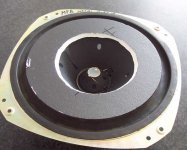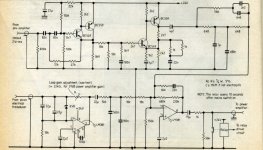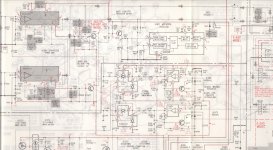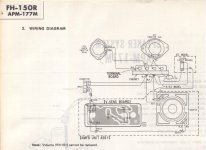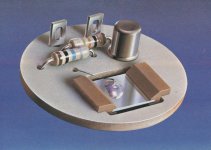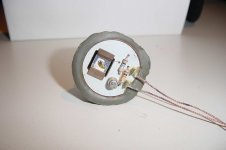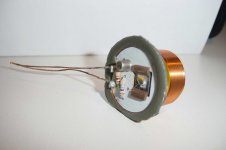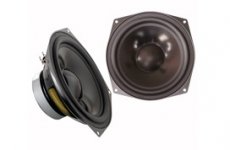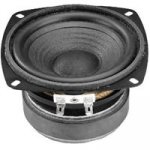Closed-Box woofers and subwoofers are not yet dead. In the seventies, Philips had a system named MFB (Motional FeedBack), a Closed Box loudspeaker where there is an accelerometer on the cone, and a dedicated power amplifier. The accelerometer registers the actual cone movement, and acts as feedback element in a servo loop with the amplifier. You still need the same big cone excursion for delivering a decent deep bass sound intensity, but you annihilate most of the distorsion caused by the big excursion. The Velodyne subwoofers reintroduced the same principle later on.
See this is in small scale speaker with scary bass response performance at DSPeaker-DSPeaker Servo 300Pro
-mikko
yeah youre right better take the 12" TVM -10dB 25Hz. In a stuffed box of 56 liter. Unstuffed 68 liter.What do you think of SB Acoustics SB-29NRX75-6 is about 50 litre closed box? Seems (with WinISD sims) that it goes to 25 Hz -10 dB so it may give nice bass with natural room gain. Better it would be if woofer was 12" or 15" but the box size...

See this is in small scale speaker with scary bass response performance at DSPeaker-DSPeaker Servo 300Pro
-mikko
Just buy a hypex modele with dsp for your own two way 2x100W class-D design active DSPspeaker with remote control.
An externally hosted image should be here but it was not working when we last tested it.
https://www.hypexshop.com/
Last edited:
yeah youre right better take the 12" TVM -10dB 25Hz. In a stuffed box of 56 liter. Unstuffed 68 liter.

Looks like nice driver! SB29 has bit too high Qts for closed.
What benefits is to unstuff the box if it demands higher volume? Does stuffing worse transients or what?
Completely wrong. Such Hypex module doesn't support acceleration or velocity or position feedback. You need a heavy PCB tweak, isolating the power amplifier input and adding a daughterboard containing a few opamps. It is feasible, but not recommended as the class-D amp may cause surprises once embedded in the required servo loop. You better use chipamps like TDA7293 or LM3886, possibly wired as current sources instead of voltage sources. If you target a clean transient response and a linear phase, you do a 3-way speaker using a Baekgaard crossover (Low Q 2nd order state variable filter application - KHN BiQuad) with a high quality medium speaker like Dynavox FE87 or FR88. In order to keep the whole stuff compact, use the Visaton CP13 tweeter. If you want to avoid directivity issues, use the WMTM layout. DSP is not mandatory. A few opamps suffice. Oh, you need of course a sensor in the woofer. Read the Philips 22RH532 service manual, then you'll know how to build and how tu use such sensor. Picture of F9638 Flat Membrane MFB Woofer provided by Helmut.Just buy a Hypex module with dsp for your own two way 2x100W class-D design active DSPspeaker with remote control.
Attachments
Last edited:
With stuffing the box volume can increase virtual 10-20% for the driver. So box volume X 1.1 (or 1.2) after stuffing. Every time I was experimenting I came out I only like light stuffing of a box.Looks like nice driver! SB29 has bit too high Qts for closed.
What benefits is to unstuff the box if it demands higher volume? Does stuffing worse transients or what?
When the damping material isn't loose enough the box volume starts to decrease so then you get the opposite effect.
I've noticed that most of the companies making wall mount speakers (for instance Artcoustic, http://www.artcoustic.com ) use closed box design. Obviously baffle step boosts for low frequencies stay in control better with closed box designs, but could A.S work well against wall?
Hi StephCompletely wrong. Such Hypex module doesn't support acceleration or velocity or position feedback. You need a heavy PCB tweak, isolating the power amplifier input and adding a daughterboard containing a few opamps. It is feasible, but not recommended as the class-D amp may cause surprises once embedded in the required servo loop. You better use chipamps like TDA7293 or LM3886, possibly wired as current sources instead of voltage sources. If you target a clean transient response and a linear phase, you do a 3-way speaker using a Baekgaard crossover (Low Q 2nd order state variable filter application - KHN BiQuad) with a high quality medium speaker like Dynavox FE87 or FR88. In order to keep the whole stuff compact, use the Visaton CP13 tweeter. If you want to avoid directivity issues, use the WMTM layout. DSP is not mandatory. A few opamps suffice. Oh, you need of course a sensor in the woofer. Read the Philips 22RH532 service manual, then you'll know how to build and how tu use such sensor. Picture of F9638 Flat Membrane MFB Woofer provided by Helmut.
A shame you did not really realized the baeckgaard idea, you got the knowledge. Not every one here has your theoretical capabilities to make such a design. It would be cool you build one to share the technique.
http://www.diyaudio.com/forums/multi-way/174276-wmtmw-baekgaard.html
Last edited:
hi Helmuth, the issue with the MFB are the tremors and vibrations induced by the big woofer excursions. After having built one, I felt that two woofers are actually needed per loudspeaker cabinet, firing symmetric. Front+Rear and/or Left+Right firing. This way the enclosure gravity center doesn't move anymore. How would you manage the motional feedback ? Equipping all woofers with a sensor ? Averaging the sensor outputs ? In his Sept 1981 Wireless World article, De Greef used two MFB woofers, but only one sensor. Imagine a solution using 4 woofers, but only 1 equipped with a MFB sensor. What inexpensive 8 inch woofer would you advise ?
Attachments
Last edited:
hi Helmuth, the issue with the MFB are the tremors and vibrations induced by the big woofer excursions. After having built one, I felt that two woofers are actually needed per loudspeaker cabinet, firing symmetric. Front+Rear and/or Left+Right firing. This way the enclosure gravity center doesn't move anymore. How would you manage the motional feedback ? Equipping all woofers with a sensor ? Averaging the sensor outputs ? In his Sept 1981 Wireless World article, De Greef used two MFB woofers, but only one sensor. Imagine a solution using 4 woofers, but only 1 equipped with a MFB sensor. What inexpensive 8 inch woofer would you advise ?
Thinking about the sensor functioning in a two woofer box, it will be possible to equip one woofer with a sensor and ad the sensor mass to the other for symmetry.
Very low cost 8 inch woofers can be find by TVM-acoustics a 8" cost 16 euro! X-max 3,5mm.
TVM Acoustics, Valašské Meziøíèí - Woofers
But for 20 euro more we can have a aluminium frame 6,5mm liniair extrusion. The mivoc AW2000 cost 35 euro. Certainly worth the extra money.
I would cut out the center cap and leave the part glued to the cone where it is and buy a new center-cap and glue it over the modification.
centercap ebay.
http://www.ebay.com/itm/6-3-8-Inverted-Poly-Speaker-Subwoofer-Dust-Cap-Kit-/290552315687?pt=Car_Subwoofers_Enclosures&hash=item43a6447f27#ht_971wt_936
speaker trade - mivoc - Einzelchassis - AW 2000

Last edited:
Also the Dynavox DY-200 at 23,90 eur for one pair + shipment
DYNAVOX DY 200 BASSLAUTSPRECHER 200 MM - 1 PAAR | eBay
DYNAVOX DY 200 BASSLAUTSPRECHER 200 MM - 1 PAAR | eBay
Attachments
Could not resist mentionning the 1986 Elektor article from R.Conell, hosted by mfbfreaks.
http://www.mfbfreaks.com/theorie/elektuur1986mfb.pdf
http://www.mfbfreaks.com/theorie/elektuur1986mfb.pdf
I was on the official dynafox site it seems obsolete to me.Also the Dynavox DY-200 at 23,90 eur for one pair + shipment
DYNAVOX DY 200 BASSLAUTSPRECHER 200 MM - 1 PAAR | eBay
A more expensive one visaton WS20E 27euro is more than 20 years in production. May be a bit low efficiency. PPcone. nice for TL
Visaton - Lautsprecher und Zubehör, Loudspeakers and Accessories
..Btw Radio Shack's "mighty mouse" Minimus 7 is one of the models I think of when discussing the potentia) size advantage of a classic acoustic-suspension design. RS used to sell that 4" woofer the 7 used, and it had the heavy cone and compliant suspension I associate with an a.s. speaker, along with a large motor structure nearly as large as the cone itself (the woofer utilized that strange shiny greenish foam-ish material that only RS used and doesn't seem to be susceptible to rot, even after three decades!) ---> page 23 and listed - click on page to enlarge - as a "long throw woofer" along with a brief spec chart...
Hi FYI,
I still use those great drivers for two bookshelf arrays(2x5) with td> 42 mS using an A+B summed signal at slightly above JND level or sometimes at an higher level for some records.
Although an As design would be a perfect use for these divers ,I went for a larger Vb volume.
b🙂
Attachments
Do you think Realistic 40-1022 can be substituted by Monacor SP100/8 ? Haut-parleur grave-médium Monacor SP-100/8Hi FYI, I still use those great drivers for two bookshelf arrays(2x5) with td> 42 mS using an A+B summed signal at slightly above JND level or sometimes at an higher level for some records. Although an As design would be a perfect use for these divers ,I went for a larger Vb volume. b🙂
Attachments
Do you think Realistic 40-1022 can be substituted by Monacor SP100/8 ? Haut-parleur grave-médium Monacor SP-100/8
Hi steph_tsf,
Yes I do if for an AS speaker but if you want to try an frontally placed delayed array I think you need to adjust the FR a bit, See my picture hints:
b🙂
Attachments
Back to the original question.
The question is not about closed box but acoustic suspension.
The idea was just an economical point of view, to can sell less expensive and smaller enclosures.
In a closed box, the air compression is added to the forces of the loudspeaker suspension, so the resonance frequency increase. The original simple idea was to use a less rigid suspension, with a very low resonance frequency, using air inside the enclosure as the real suspension. This works only in little enclosures (i can explain why, but it is obvious). Then for little speakers, with low FS, so very low efficiency.
Low efficiency is a bad idea.
AR came with those kind of little enclosures, The size was amazingly little, comparing with the JBL, ALTEC, KLIPSH etc. previous big systems. And it was making some kind of basses, despite their sizes.
In the same time it had kill a lot of qualities of the previous way to reproduce music: low distortions, dynamic, high levels etc. where lost.
After some dark years "on the mood", this bad idea has been, happily, mostly forgotten by loudspeakers manufacturers, and, 30 years after, it seems we are back to better systems. High efficiency is back again.
Now, you can prefer bass reflex, quarter wave lines, flat panels, symmetrically loaded delta, passive drver ;-(, or large closed enclosures with big high efficiency bass drivers, all those systems had their own advantages and inconvenience. But it is no more "air suspension".
As far i'm concerned (and involved in that) i would say: "Acoustic suspension idea had killed good sound during decades ".
The question is not about closed box but acoustic suspension.
The idea was just an economical point of view, to can sell less expensive and smaller enclosures.
In a closed box, the air compression is added to the forces of the loudspeaker suspension, so the resonance frequency increase. The original simple idea was to use a less rigid suspension, with a very low resonance frequency, using air inside the enclosure as the real suspension. This works only in little enclosures (i can explain why, but it is obvious). Then for little speakers, with low FS, so very low efficiency.
Low efficiency is a bad idea.
AR came with those kind of little enclosures, The size was amazingly little, comparing with the JBL, ALTEC, KLIPSH etc. previous big systems. And it was making some kind of basses, despite their sizes.
In the same time it had kill a lot of qualities of the previous way to reproduce music: low distortions, dynamic, high levels etc. where lost.
After some dark years "on the mood", this bad idea has been, happily, mostly forgotten by loudspeakers manufacturers, and, 30 years after, it seems we are back to better systems. High efficiency is back again.
Now, you can prefer bass reflex, quarter wave lines, flat panels, symmetrically loaded delta, passive drver ;-(, or large closed enclosures with big high efficiency bass drivers, all those systems had their own advantages and inconvenience. But it is no more "air suspension".
As far i'm concerned (and involved in that) i would say: "Acoustic suspension idea had killed good sound during decades ".
Last edited:
Very nice Linkwitz Transform application ! Much appreciated !Hi steph_tsf, Yes I do if for an AS speaker but if you want to try an frontally placed delayed array I think you need to adjust the FR a bit, See my picture hints
Back to the original question.
The question is not about closed box but acoustic suspension.
The idea was just an economical point of view, to can sell less expensive and smaller enclosures.
In a closed box, the air compression is added to the forces of the loudspeaker suspension, so the resonance frequency increase. The original simple idea was to use a less rigid suspension, with a very low resonance frequency, using air inside the enclosure as the real suspension. This works only in little enclosures (i can explain why, but it is obvious). Then for little speakers, with low FS, so very low efficiency.
Low efficiency is a bad idea.
Now, you can prefer bass reflex, quarter wave lines, flat panels, symmetrically loaded delta, passive drver ;-(, or large closed enclosures with big high efficiency bass drivers, all those systems had their own advantages and inconvenience. But it is no more "air suspension".
As far i'm concerned (and involved in that) i would say: "Acoustic suspension idea had killed good sound during decades ".
So you mean that air suspension is no more in bigger enclosures even if there's big bass driver? Does air suspension truly work with smaller cones (which demand longer xmax for move air) in their smaller boxes? So big bass drivers should always be in bass reflex (which makes bass response that usually do not fit into room as good as with sealed box)?
Whatever the answer to the original question: it is sad that drivers designed for AS are so hard to find. When I designed my subs I had to buy a pair of 20-year-old Audio Concepts drivers to find something suitable for Acoustic Suspension. I didn't know about many of the sources posted in this thread. What also irks me is that many drivers (e.g. Dayton's subwoofer line) are described as being suitable to either ported or closed box. IMO a driver designed for both is not optimized for either.
- Status
- Not open for further replies.
- Home
- Loudspeakers
- Multi-Way
- What killed off the acoustic-suspension speaker?
